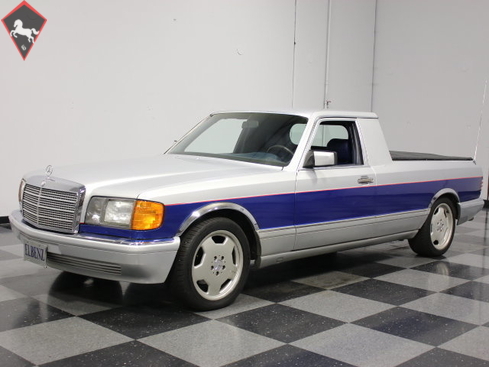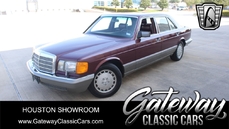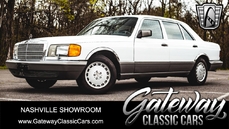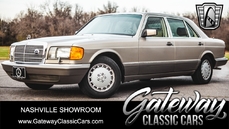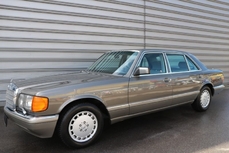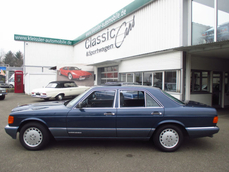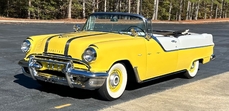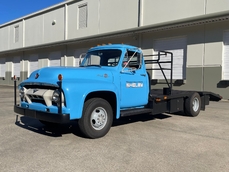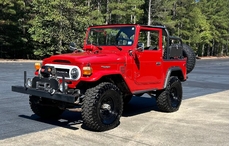Mercedes-Benz 420 SE/L w126 4.2 Liter V8 1988
General description :
A DREAM REALIZED: THE LUXURY MERCAMINO, HIGH-END CUSTOM BUILD, 2 MUCH 2 LIST!!
Need a parts chaser with a bit of German flavor? How about the most attention-grabbing hauler you've ever seen? However you slice it, this 1988 Mercedes-Benz 420SEL pickup isn't your average Autobahn stormer. Custom built by the guys at German Motorcars in Florida, it's a beautifully rendered German version of a purely American invention.
Starting life as a prestigious 420SEL luxury sedan, this awesome truck/car now has an ultra-clean look that looks like it could have come from the factory in all of this glory. The silver and blue paint combination looks vaguely reminiscent of the factory's dealer service vehicles, and that might be purely intentional on the builder's part. Of course, it's like nothing the factory's ever built for public consumption, but that doesn't make it any less cool. The original S-Class sedan was sectioned behind the front seats and a custom bulkhead was built to separate the passenger compartment from the bed. Then the entire bed was hand-fabricated and the bodywork was extensively modified to keep its Mercedes-Benz identity but with an entirely different shape. The doors, quarter panels, and trunk lid were all sectioned and salvaged to retain the OEM look, but they're so seamlessly stitched together that you'll never spot the modifications. It's got a few signs of use here and there, but that's hardly a demerit for a car this useful. A few chrome pieces keep its upscale vibe, and with the big grille and three-pointed star emblems, nobody will ever mistake this for anything but a high-end luxury cruiser.
The interior keeps all its Mercedes-Benz bits as well, including the supportive blue leather bucket seats. In fact, the door panels, carpets, dashboard, and all the controls are completely stock and fully functional, making this one of the most luxurious pickup truck ever designed. A big steering wheel frames familiar Mercedes-Benz gauges, the Teutonic shifter still manages the transmission, and the stereo system was heavily upgraded to fill the modified passenger compartment with sound. Things like automatic climate control, power windows and locks, cruise control, and those cool pictograms for the power seats all remain in place, so from behind the wheel, you'll never even notice the modifications. Everything works, too, which is always a nice perk.
Although the badge on the tail says "KOMPRESSOR" (which is German for supercharger), this is a stock 4.2 liter OHC V8, the same one that has powered these cars for decades. Smooth, torquey, and capable of cruising for hours on end at triple-digit speeds, it's still an awesome choice for a truck, er, car like this. It was rebuilt when the truck conversion was done, which was about 35,000 miles ago, and given the durability of these machines, it should out last us all. Bright blue cam covers highlight the largely stock engine bay and you can see that there are quite a few new components throughout. The A/C has been converted to R134a refrigerant for ease of maintenance and many of the belts and hoses are new. The 4-speed automatic overdrive transmission changes gears without any drama and the fully independent suspension still feels supple and sophisticated. Four-wheel discs are standard equipment, too, and a recent exhaust system has just the right V8 rumble, but it's ever so hushed. Late-model AMG alloys complete the OEM look and carry a recent set of 235/45/17 Continental performance radials.
It's definitely unusual, but the build quality and the awesome look will make this Mercedes the star of any show it enters, and it's remarkably practical to boot! Call today! VIN:WDB1260351A408542
This vehicle is not currently in one of our showrooms. Please set up an appointment to view this car in person.
Features : Air Conditioning, AM/FM Radio, CD Player, Cruise Control, Defrost, Driver Airbag, Four Wheel Disc Brakes, Heat, Leather Seats, Power Brakes, Power Locks, Power Seats, Power Steering, Power Windows, Seatbelts
http://www.streetsideclassics.com/vehicles/2485-atl/1988-mercedes-benz-420sel
1988 Mercedes-Benz 420 SE/L w126 4.2 Liter V8 is listed sold on ClassicDigest in Lithia Springs by Streetside Classics for $14995.
Car Facts
Car type : Car Make : Mercedes-Benz Model : 420 SE/L w126 Model Version : 4.2 Liter V8 Engine size : 0.0 Model Year : 1988 Sub type : Pick up Location : Atlanta
Sold
Seller Information
Sold
People who viewed this Mercedes-Benz 420 SE/L w126 also viewed similar Mercedes-Benz listed at ClassicDigest
Other cars listed for sale by this dealer
About Mercedes-Benz
In the annals of automotive history, the journey of Mercedes-Benz is a tale that unfolds with the ingenuity of its founding pioneers. In the year 1886, Karl Benz crafted the Benz Patent Motorwagen, a creation that would go down in history as the world's inaugural automobile. Unbeknownst to him, this moment marked the genesis of what would evolve into the most illustrious premium car manufacturer globally. The financial underpinning of this pioneering venture, interestingly, was provided by Karl Benz's wife, Bertha Benz, demonstrating a remarkable partnership that would set the tone for Mercedes-Benz's legacy.A parallel narrative emerged not far away, as Daimler-Motoren-Gesellschaft, founded by Gottlieb Daimler and Wilhelm Maybach, entered the scene. In 1901, they unveiled their automobile under the now-famous moniker "Mercedes," meaning "godsend" in Spanish. This name was bestowed upon the car at the behest of Emil Jellinek's daughter, the distributor for Daimler-Motoren-Gesellschaft. The wheels of innovation were set in motion.
Fast forward to 1926, a pivotal year that witnessed the merger of Daimler with Benz & Cie., culminating in the birth of Daimler-Benz. The amalgamation saw the adoption of "Mercedes-Benz" as the distinguished trademark for their automobiles, fusing the legacies of two visionary entities into one.
Contrary to perceptions of conservatism, the trajectory of Daimler-Benz unfolds as a chronicle of industry firsts. From the introduction of the honeycomb radiator to the float carburetor, and the pioneering implementation of four-wheel brakes in 1924, Daimler-Benz consistently pushed the boundaries of automotive innovation. The diesel-powered Mercedes-Benz 260 D in 1936 marked the inception of diesel engines in passenger cars. The iconic Mercedes-Benz 300SL Gullwing made history as the first car with direct fuel injection, albeit the Gutbrod's tiny 2-stroke engine can claim precedence.
Safety innovations became a hallmark, with Béla Barényi's patented safety cell design in the "Ponton"-models in 1951, featuring front and rear crumple zones. The W116 450SEL 6.9 saw the introduction of the Anti-Lock Brake system (ABS), another pioneering safety feature. From the first production airbags and beyond, the legacy of "firsts" continued to be etched into the fabric of Daimler-Benz.
Over its centennial journey, Mercedes-Benz has not merely produced cars but has sculpted automotive icons. The SSKL, 710 SSK Trossi Roadster, 770K Grosser, 540K Spezial Roadster, 300SL Gullwing, w100 600 Pullman, w111 280SE 3.5 Flachkühler, w113 230SL Pagoda, w109 300 SEL 6.3, and w201 2.3-16 Cosworth stand testament to the brand's commitment to engineering excellence.
The roaring Silver Arrows, or "Silberpfeile," including the W 25, W 125, W154, W165, and W196, created a legacy of dominance on the racetrack. These machines were not merely cars; they were expressions of precision, speed, and an indomitable spirit that left their competitors in the dust.
As Mercedes-Benz marches into the future, it does so not just as an automaker but as a custodian of a legacy, a torchbearer of innovation, and a beacon of automotive excellence. The road ahead is sure to witness the continued fusion of cutting-edge technology, timeless design, and an unwavering commitment to setting new standards in the world of automobiles.
One luminary figure who left an indelible mark was Béla Barényi, often heralded as the "father of passive safety" for his pioneering work in safety engineering. His patented safety cell design, featuring front and rear crumple zones, became a hallmark of Mercedes-Benz's commitment to occupant safety, setting new standards that reverberated throughout the automotive world.
Moving through the chronicles, the collaborative genius of Wilhelm Maybach, alongside Gottlieb Daimler, laid the foundation for Daimler-Motoren-Gesellschaft. Their innovations not only birthed the first Mercedes but established a culture of relentless pursuit of technological excellence that remains integral to Mercedes-Benz's DNA.
In the post-merger era of 1926, Ferdinand Porsche emerged as a prominent figure within Mercedes-Benz. His work on the Mercedes-Benz S-Type, a supercharged race car, garnered acclaim and set the stage for a legacy that extended far beyond the marque. Porsche's impact would later extend to his eponymous company, but his influence at Mercedes-Benz during those formative years was pivotal.
As the 20th century progressed, the legendary Rudolf Uhlenhaut emerged as a key figure. Uhlenhaut, an accomplished engineer and the driving force behind the iconic Silver Arrows, played a crucial role in Mercedes-Benz's dominance in motorsports. His engineering prowess and attention to detail were instrumental in creating some of the most formidable racing cars of the era.
In the latter half of the century, figures like Bruno Sacco, the head of design at Mercedes-Benz from 1975 to 1999, left an indelible imprint on the brand's aesthetic identity. Sacco's design philosophy, characterized by clean lines and timeless elegance, shaped iconic models like the W126 S-Class and the W201 190E, solidifying Mercedes-Benz's reputation for luxury and sophistication.
The narrative would be incomplete without acknowledging the contributions of engineers like Hans Scherenberg, whose leadership in the 1970s ushered in a new era of technological innovation at Mercedes-Benz. Scherenberg's tenure saw the development of groundbreaking technologies, including the Anti-Lock Brake system (ABS) and the introduction of airbags in production cars.
